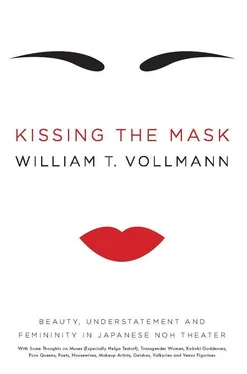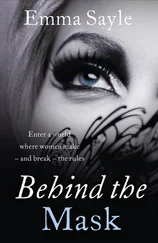The unanswerable question, “What is a woman?” can be approximated, “What manifests a woman?” — in other words, how does somebody of either sex express, we might as well say, herself in such a way that we perceive or interpret her femininity? To Zeami the matter was as straightforward as anything can be in Noh: Get expert advice when playing court ladies, since their dress has been so carefully regulated and conventionalized; observe and emulate the costuming of the lowborn women who flourish all around us like weeds; mind a few general rules: “He must not bend too much at the waist or at the knees… He does not look like a woman when he holds his head too rigidly.” Summing up, “in the impersonation of women the dressing is the fundamental thing for the actor.” These maxims are still followed today in the red-light district of Kabukicho, where there is a bar especially for “new-halves,” as transvestites are called in Japanese. One such sweet, shy, plump young lady, who happened to be dressed in white, whose curls were blonde, whose lips were richly red, and who kept ready any number of name-cards which bore her full-color likeness and e-mail address, was kind enough, after compensation had been arranged, to discuss this issue, which is, after all, of considerable aesthetic as well as sociobiological concern to us all.
“What does being a woman feel like, and how does that differ from being a man?”
She smiled, slowly lowering her hand through the air. “There’s no difference,” she said. “My heart feels the same.”
As we have heard, Mr. Umewaka likewise feels nothing when he’s a woman, or when he plays any other part, for that matter. He strives to feel nothing. He’s a man-woman in a doll-perfect mask, facing forward, singsonging in a deep voice. From the back he is always wide and flat like a beetle, a paper cutout, with his black hair spilling perfectly down. Miss Tosaka, 7on the other hand, is built for use. She has a rather nice bottom.
“What is the secret of being a convincing woman?”
“Ah,” Miss Tosaka replied, slowly drawing a circle in the air, and my interpreter of the moment, the versatile Reiko, reported: “It seems that there’s no secret.”
“So how do you behave?”
“I act naturally. I don’t care about how people regard me, how others look at me, as long as they are accepting. I do try to walk differently.”
“How does one walk like a woman?”
“When I’m a woman, I try to keep my knees together. I take very short steps. When I sit down, I keep my legs together.”
I had just interviewed one of the rare Noh actresses, a middle-aged lady named Yamamura Yoko, who has studied with Mr. Umewaka for twenty years and, of course, reveres him. She claimed that “mentally you’re calmer in a kimono, and although your voice doesn’t change, you sound more deliberate.” — Miss Tosaka for her part had worn a kimono only once, for the very practical reason that “you have to pay some professional person to dress you in it, because so many Japanese can’t do this ourselves anymore; that art is lost.” (I thought of Mr. Umewaka surrounded by all his apprentice-helpers in the dressing room.) — “I also like dresses,” she volunteered, but it seemed to me that she referred to her evening in the kimono with a certain wistfulness.
“Did it make you feel more feminine?”
“You know, it was very tight,” she said, smiling sweetly and generously, “so I couldn’t walk in long strides; it also kept my body very straight; so, yes, I did feel like a woman.”
This certainly corresponds to Zeami’s advice to hold one’s body rigid, except for the head, when becoming a female; but Mr. Umewaka experienced a sense of confinement when he was being dressed for his various roles of either gender; and when I observe the quasi-mechanical action of Noh’s dolls, whose faces so frequently downturn to express angelic sadness, without knowing the drama it can be difficult to distinguish male from female. Restriction is the very essence of Noh — or at least creates that essence. “Mentally I am comfortable,” he remarked, “but physically it’s not easy to move. The wig and mask hurt the head. It’s difficult to breathe.” (As we say in America, no price too great for beauty!) And yet he seems to move with a dreamy effortlessness. When he’s the abandoned wife in “Kinuta,” he rotates with remarkable slowness and sureness, never revealing any indication that his legs are moving beneath the long pale wings of the kimono. Once he’s become her ghost, he bitterly touches his outstretched golden fan to the stage as he kneels…
“When you act in a female role, what, if anything, do you do differently?”
“Basically, it should be the same,” he replied, which surprised me. 8“But the steps are a little smaller, and the arm movements are a little narrower.”
I relayed what Miss Tosaka had said about keeping one’s legs together, and he remarked that such would be Kabuki style. Kabuki actors train for female roles by walking with a sheet of paper between the knees. “In Noh,” he said, “originally it was like that, too. But as time passed, it became more abstract.”
In other words, so it seemed to me, Zeami is now partially superseded. (Probably this means that I misunderstand Zeami. Mr. Umewaka makes a point of withholding from his apprentices for several years his family’s Zeami manuscript, because “unless you master Noh to some extent, you interpret the instructions incorrectly.”) Noh is not what it was. From a quasi-religious rite accessible to all, 9to a leisure art explicitly restricted to nobles, to a resurrected tradition requiring either study or snobbery on the part of its audiences, Noh has grown ever more arcane (in the play “Miidera” the protagonist holds a bamboo branch over one shoulder. Why should this signify that the female character is deranged? Don’t ask!), but the compensation for this lack of popular resonance is this very abstraction which Mr. Umewaka mentions. When one of his roles requires him to express sadness, he holds his hand before his face. If he’s a man at that time, he uses the right hand; if a woman, then the left. Perhaps in Zeami’s time this was in fact an observable behavioral distinction between the sexes. In present-day Japan it is not. 10Therefore, both the actors and the spectators must learn it for it to convey anything.
In a sense, both Miss Tosaka and Mr. Umewaka are artists, but she has made herself what she is almost literally: a lovely lady of today; 11whereas Mr. Umewaka, in spite of his young woman’s mask-face with its perpetual half-smile, is what he is figuratively , “abstractly” as he put it. As Ms. Yamamura said of him, “On the Noh stage, looking at him acting, you can see much more than is objectively there. In that sense, he’s the best.” In short, he does not merely imitate the mannerisms of a female. He stylizes that imitation in a manner which is archaic, non-representational, or both; and after decades of following that maxim of Zeami, there must be no self-assertion , he is an expressive vehicle for something greater than himself. Yes, he’s aided by his mask and kimono. Every artist needs his tools. But I truly believe (no doubt he’d modestly deny it) that with no other attributes than his broad, kindly face, his thick grey eyebrows, his missing tooth, his whitehaired temples and slightly sunken eyes, his rotundity, his man’s voice, he would still be able to make those bygone young women of the Noh dramas live , and gorgeously. 12
And so, imagine what this man, with his perfect command of gesture, carriage and voice, can accomplish in a mask.
Which one will he choose? As I’ve said, it depends in part upon the music, in part upon his interpretation of the role. Regarding Shuntoku-maru, the blind vagrant with the uncertain step, he remarked: “There is a mask called Yoroboshi, but I did not use it. I used a mask for the blind man Semimaru 13because it is more elegant…”
Читать дальше












